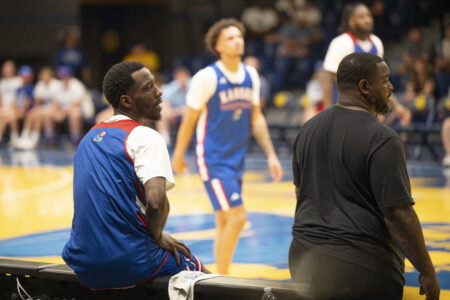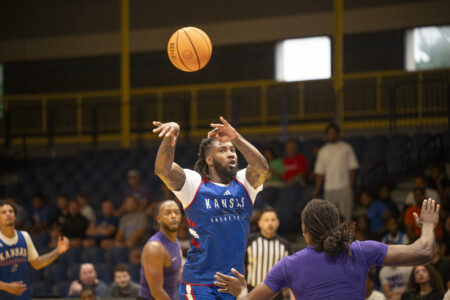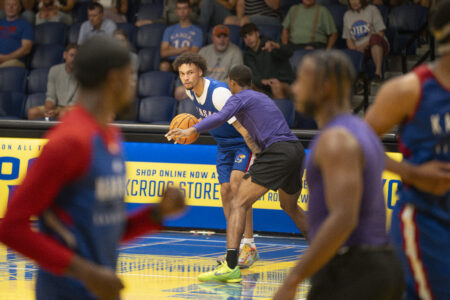Greats’ grandsons
Three Firebirds trace lineage to '52 Jayhawks

Three current Free State High basketball players are grandsons of members of the 1952 Kansas University basketball team that won the national championship and the Olympic gold medal. They are, from left, Bill Hougland and his grandson Matthew Ruder; Charlie Hoag and Chase Hoag; and Bill Lienhard and grandson Ryan Scott.
When Free State High junior Chase Hoag was in sixth grade, he experienced something very few young men get to encounter during their lifetime.
Hoag, a budding basketball fanatic, had a one-on-one conversation in his living room with legendary coach and former Jayhawk Dean Smith.
“At the time, I didn’t understand it completely,” Hoag said. “But looking back on it, it kind of blows my mind. I wish I would’ve had more to say. I wish I would’ve asked him a few more questions about basketball.”
Not to worry. The chance hasn’t disappeared. Hoag’s grandfather, Charlie, is a friend of Smith’s. The two played basketball together during their time at Kansas University and remain close friends to this day.
Even if Smith isn’t able to make it to Lawrence to chat with Chase, Charlie Hoag is always around, providing a direct connection between Chase and the gloried past of Kansas basketball.
Chase isn’t alone in being so lucky.
FSHS is home to three players who favor the simplicity of the game to the razzle-dazzle around them. Hoag, along with junior Ryan Scott and sophomore Matt Ruder, are as old-school as high school players come these days. They all prefer the hustle play to the highlight and constantly seek to make the game easier by utilizing the techniques and fundamentals the game was founded upon.
Free State’s throwback players come by it honestly. All three are grandsons of former Jayhawks who won a national championship with KU in 1952 and an Olympic gold medal the same year.
“I’d definitely say Chase and Ryan are two of our more old-school players,” said Free State varsity coach Chuck Law. “Clearly, they’ve learned a lot from their grandfathers. To have a chance to sit down and talk to someone who played for Phog Allen whenever you want, it’s amazing.”
‘You don’t have to be a star’
All three grandfathers – Charlie Hoag, Bill Hougland and Bill Lienhard – live in Lawrence today, giving them the opportunity to watch their grandsons as well as follow the current KU team.
“After every game of mine, (Hougland) always gives me tips,” said Ruder, a member of Free State’s sophomore squad. “The biggest thing he’s said that’s stuck with me is that you don’t have to be a star, you just have to play hard and have fun doing it. That’s what I try to do.”
Such a philosophy undoubtedly came from legendary KU coach Phog Allen, whom all three grandfathers played for during their time as Jayhawks.
Ruder remembers first hearing Hougland’s stories about Allen when he was 10. Scott recalls hearing similar stories on the days when he and Lienhard would play H-O-R-S-E in the driveway.
Although the sessions were primarily about a grandfather spending quality time with his grandson, Lienhard admitted that he always kept a watchful eye on Scott’s technique.
“The biggest thing for me,” Lienhard said, “is today’s athletes have forgotten how to shoot the ball properly. So that’s one of the things I’ve always tried to emphasize. Ryan’s got a real good shot. I used to beat him and his friends all the time, but then one day Ryan beat me so I quit playing.”
‘It’s fun to brag about him’
Scott said he felt no shame in losing to a man who once won a national title and gold medal in the same year.
“It’s fun to brag about him and think about what he did,” Scott said. “He taught me most of what I know about the game of basketball.”
Of the three, Lienhard was the highest scorer in the Jayhawks’ 80-63 victory over St. John’s in the 1952 national title game. He shot 5-of-8 from the floor and was 2-of-2 from the free-throw line. He also chipped in four rebounds.
Hougland finished with five points and six rebounds, and Hoag, who also was a Heisman-caliber running back at KU, finished with nine points and four rebounds.
“The three of us combined had almost as much as one guy in that game,” Hoag joked, speaking of MVP Clyde Lovellette’s 33-point, 17-rebound performance.
The 1952 NCAA Tournament was the first to have regional television coverage and the first to follow the current Final Four format, where teams advance from four different regionals to play for the title.
“In talking with (my grandfather) about those games, I just listen to everything he has to say and hang on every word,” Chase said. “Hearing what they accomplished and the way they did it has really inspired me.”
Olympic gold, too
About four months after winning the NCAA title in Seattle, the trio and four other Jayhawks traveled to Helsinki, Finland, to play in the Olympic Games. The Americans were coached by Warren Womble. Allen was an assistant. In recalling the stories from 1952, all three pointed to Dick Harp, Allen’s assistant at KU, as a major reason for their triumphs during the magical year.
“Dick Harp was a very, very, very important part of us being successful,” Charlie Hoag said. “He should’ve been at the Olympics with us.”
After rolling to victory in six straight pool play games and dispatching Argentina in the semifinals, Team USA defeated the Soviet Union, 36-25, in the gold-medal game.
“Any good college team could’ve won the gold,” Lienhard said. “Because in those days we were so far ahead in terms of basketball ability. The Soviets just bulled their way over everyone, but they weren’t very good.”
The transformation of the game of basketball from 1952 to the present day has been dramatic.
Behind-the-back passes and alley-oops have taken the place of bounce passes and hook shots, but the game continues to flourish despite the ongoing changes.
One of the most common explanations for basketball’s change is generational. In years past, the athletes preferred the simple play – a chest pass, a backdoor cut or a set shot off the glass. Today’s athletes, however, bask in the highlight-reel world in which they live. The spin move or flashy pass often is a weapon of choice, even when a straight path or fundamental pass would suffice.
“It’s a different game today,” Lienhard said. “We would be in slow motion compared to today’s KU team. But it’s still a great game.”
When Hoag, Hougland and Lienhard watch today’s action, they sit back and smile. Occasionally, they laugh at the thought of what might have happened in their day under Allen’s watch, if they tried some of the moves they see on the court today.
“We wouldn’t have played again if we even tried to throw a behind-the-back pass,” Hougland said. “Doc wouldn’t let ya. But these guys today, they still have the fundamentals, they’re just quicker fundamentals because they’re better athletes.”







